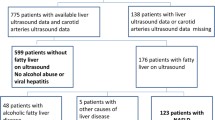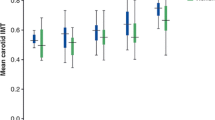Abstract
Aim The aim of this study was to evaluate metabolic syndrome (MetS) frequency and carotid artery intima-media thickness (IMT) as risk factors for atherosclerosis in patients with nonalcoholic fatty liver disease. Methods A case-control study was conducted on 40 biopsy-proven NAFLD patients and 40 age-matched healthy control subjects. Common carotid artery IMT and MetS criteria [according to the Third Report of the National Cholesterol Education Expert Panel on Detection, evaluation, and Treatment of High Blood Cholesterol in Adults (NCEP-ATPIII), the International Diabetes Federation (IDF), the American Heart Association in conjunction with the National Heart, Lung, and Blood Institute (AHA/NHLBI)] were evaluated for all study subjects. Results MetS according to NCEP-ATPIII, IDF and AHA/NHLBI criteria was present in 55, 67.5 and 62.5% of NAFLD patients, respectively. The mean IMT was significantly higher in NAFLD patients (0.646 ± 0.091 mm) than control subjects (0.544 ± 0.067 mm), (P < 0.001). Among the vascular risk factors evaluated, the diagnosis of NAFLD and increased body mass index were significant independent predictors of increased IMT. Conclusions As cardiovascular risk factors, both MetS and increased IMT occur frequently among NAFLD patients. Screening for both conditions might be beneficial for assessment of future atherosclerotic complications.
Similar content being viewed by others
References
Angulo P (2002) Nonalcoholic fatty liver disease. N Engl J Med 346:1221–1231
Akahoshi M, Amasaki Y, Soda M et al (2001) Correlation between fatty liver and coronary risk factors: a population study of elderly men and women in Nagasaki, Japan. Hypertens Res 24:337–343
Jepsen P, Vilstrup H, Mellemkjaer L, Thulstrup AM, Olsen JH, Baron J et al (2003) Prognosis of patients with a diagnosis of fatty liver: a registry-based cohort study. Hepatogastroenterology 50:2101–2104
Davidson MH (2005) Management of dyslipidemia in patients with complicated metabolic syndrome. Am J Cardiol 96(suppl):22E–25E
Mokdad AH, Bowman BA, Ford ES, Vinicor F, Marks JS, Koplan JP (2001) The continuing epidemics of obesity and diabetes in the United States. JAMA 286:1195–1200
Matteoni CA, Younossi ZM, Gramlich T, Bopari N, Lui YC, McCullough AJ (1999) Nonalcoholic fatty liver disease: a spectrum of clinical and pathological severity. Gastroenterology 116:1413–1419
Malik S, Wong ND, Franklin SS, Kamath TV, L’Italien GJ, Pio JR et al (2004) Impact of the metabolic syndrome on mortality from coronary heart disease, cardiovascular disease, and all causes in United States adults. Circulation 110:1245–1250
Isomaa B, Almgren P, Tuomi T, Forsen B, Lahti K, Nissen M et al (2001) Cardiovascular morbidity and mortality associated with the metabolic syndrome. Diabetes Care 24:683–689
Expert panel on detection, evaluation, and treatment of high blood cholesterol in adults. Executive Summary of the Third Report of the National Cholesterol Education Program (NCEP) Expert Panel on Detection, Evaluation, and Treatment of High Blood Cholesterol in Adults (Adult Treatment Panel III). J Am Med Assoc 285:2486–2497, (2001)
Grundy SM, Cleeman JI, Daniels SR et al (2005) Diagnosis and management of the metabolic syndrome: an American Heart Association/National Heart, Lung, and Blood Institute scientific statement. Circulation 112:2735–2752
Alberti KG, Zimmet P, Shaw J (2005) The metabolic syndrome—a new worldwide definition. Lancet 366:1059–1062
Ford ES, Giles WH, Dietz WH (2002) Prevalence of the metabolic syndrome among US adults: findings from the third National Health and Nutrition Examination Survey. JAMA 287:356–359
Isomaa B, Henricsson M, Almgren P, Tuomi T, Taskinen MR, Groop L (2001) The metabolic syndrome influences the risk of chronic complications in patients with type II diabetes. Diabetologia 44:1148–1154
O’Leary DH, Polak JF, Kronmal RA, Manolio TA, Burke GL, Wolfson SK Jr (1999) Carotid-artery intima and media thickness as a risk factor for myocardial infarction and stroke in older adults. Cardiovascular Health Study Collaborative Research Group. N Engl J Med 340:14–22
Bots ML, Hoes AW, Hofman A, Witteman JCM, Grobbee DE (1999) Cross-sectionally assessed carotid intima-media thickness relates to long-term risk of stroke, coronary heart disease and death as estimated by available risk functions. Int J Med 245:269–276
Long A, Lepoutre A, Corbillon E, Branchereau A (2002) Critical review of non- or minimally invasive methods (duplex ultrasonography, MR- and CT-angiography) for evaluating stenosis of the proximal internal carotid artery. Eur J Vasc Endovasc Surg 24:43–52
Matthews DR, Hosker JP, Rudenski AS, Naylor BA, Treacher DF, Turner RC (1985) Homeostasis model assessment: insulin resistance and beta-cell function from fasting plasma glucose and insulin concentrations in man. Diabetologia 28:412–419
Marchesini G, Bugianesi E, Forlani G, Cerrelli F, Lenzi M, Manini R, Natale S, Vanni E, Villanova N, Melchionda N, Rizzetto M (2003) Nonalcoholic fatty liver, steatohepatitis, and the metabolic syndrome. Hepatology 37:917–923
Cigolini M, Targher G, Agostino G, Tonoli M, Muggeo M, De Sandre G (1996) Liver steatosis and its relation to plasma haemostatic factors in apparently healthy males: role of the metabolic syndrome. Thromb Haemostas 76:69–73
U.S. Bureau of the Census (1997) Statistical Abstract of the United States: 1997, 117th ed. U.S. Bureau of the Census, Washington, DC
Volzke H, Robinson DM, Kleine V, Deutscher R, Hoffmann W, Ludemann J, Schminke U, Kessler C, John U (2005) Hepatic steatosis is associated with an increased risk of carotid atherosclerosis. World J Gastroenterol 28:1848–1853
Brea A, Mosquera D, Martin E, Arizti A, Cordero JL, Ros E (2005) Nonalcoholic fatty liver disease is associated with carotid atherosclerosis: a case-control study. Arterioscler Thromb Vasc Biol 25:1045–1050
Targher G, Bertolini L, Padovani R, Zenari L, Zoppini G, Falezza G (2004) Relation of nonalcoholic hepatic steatosis to early carotid atherosclerosis in healthy men: role of visceral fat accumulation. Diabetes Care 27:1498–1500
Villanova N, Moscatiello S, Ramilli S, Bugianesi E, Magalotti D, Vanni E, Zoli M, Marchesini G (2005) Endothelial dysfunction and cardiovascular risk pro.le in nonalcoholic fatty liver disease. Hepatology 42:473–478
Author information
Authors and Affiliations
Corresponding author
Rights and permissions
About this article
Cite this article
Aygun, C., Kocaman, O., Sahin, T. et al. Evaluation of Metabolic Syndrome Frequency and Carotid Artery Intima-media Thickness as Risk Factors for Atherosclerosis in Patients with Nonalcoholic Fatty Liver Disease. Dig Dis Sci 53, 1352–1357 (2008). https://doi.org/10.1007/s10620-007-9998-7
Received:
Accepted:
Published:
Issue Date:
DOI: https://doi.org/10.1007/s10620-007-9998-7




